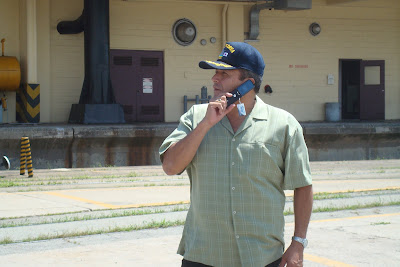In the next couple of posts, I'd like to share some of the work projects that my command, Military Sealift Command Korea is involved with. We always have a lot on our plate. Our day to day mission is supporting the many Military Sealift Command ships that come to the Korean Theater of Operations (KTO). We're also heavily involved with operational plans, Joint Chief of Staff exercises, Noncombatant Evacuation Operations (NEO), Anti-terrorism/Force Protection, Navy Reserve support, mobile communication systems community relations and other programs and initiatives.
I'm getting ahead of myself though. Let me tell you about the OPDS - Offshore Petroleum Discharge System. It's basically a ship that can pump massive amounts of fuel or potable water through long flexible pipe from the sea to the shore where port facilities are inadequate or non-existent. Jets, tanks, humvees, etc all need fuel and this is one of the ways to get it to them, even without the use of a port.
This is the old legacy OPDS - the SS Chesapeake. It can deliver fuel to the beach from 4 miles away. No it's not sinking. That's just how the equipment is configured to do its mission.
Legacy OPDS
 This is the new OPDS, or OPDS Future. The name of the ship is MV Vice Admiral Wheeler. It's a much improved system that delivers fuel from 8 miles away. This is a critical asset for the KTO. Large tankers or fuel barges hook up to the Wheeler. The Wheeler then pumps that fuel to the shore.
This is the new OPDS, or OPDS Future. The name of the ship is MV Vice Admiral Wheeler. It's a much improved system that delivers fuel from 8 miles away. This is a critical asset for the KTO. Large tankers or fuel barges hook up to the Wheeler. The Wheeler then pumps that fuel to the shore. Here is the Wheeler at my workplace, Pier 8 in Busan. You can see the reels of yellow flexible pipe. Over to the left is the USNS Pomeroy, another MSC vessel that we support.
Here is the Wheeler at my workplace, Pier 8 in Busan. You can see the reels of yellow flexible pipe. Over to the left is the USNS Pomeroy, another MSC vessel that we support.
Earlier this month, MSCO Korea supported a very important OPDS training evolution at Pohang, Korea. During this training, the OPDS deployed all 8 miles of its pipe for the first time since initial acceptance trials. This was a huge accomplishment.
 This wheeled amphibious vehicle is used to get the pipe to the beach. You can see the Wheeler way off in the background.
This wheeled amphibious vehicle is used to get the pipe to the beach. You can see the Wheeler way off in the background. Imagine this important capability in a Katrina-type humanitarian assistance / disaster relief scenario. The OPDS would be capable of delivering life saving potable water from miles away. In my opinion, we need more of these vessels.
Imagine this important capability in a Katrina-type humanitarian assistance / disaster relief scenario. The OPDS would be capable of delivering life saving potable water from miles away. In my opinion, we need more of these vessels.
Here are some of the folks that made this evolution a success. There was heavy coordination between the Republic of Korea (ROK) Navy to keep fishing boats and other marine traffic clear of the OPDS. We also worked with the ROK Marines to keep the beach secure. Our Navy Reservists set up the Mobile Sealift Operations Center (MSOC) communications van to stay appraised of the training evolution. The Navy Reservists from Expeditionary Port Unit 102 and NR Sealift Logistics Command Far East did a fantastic job supporting this important mission.
One more picture. This is my Operations Officer, Mr. Xavier Monroy. He was the key person in making this training evolution happen. Just one example of why he was named the 2009 US Forces Korea (USFK) Civilian Employee of the Year. Don't know what I'd do without him.
Hope you enjoyed this peek into some of the things that happen at work. It's challenging but very rewarding work. On any given day, I'm coordinating with ROK military, ROK government agencies, ship's crew, Navy Reservists from all over the country and of course our Army, Navy, Air Force and Marine counterparts here in Korea.
Hmm, I'm wondering if you could pump Captain Morgan's rum through the OPDS pipe in a beach bonfire party scenario? Just kidding. I meant pina colada. Until next time -- C2


















0 comments:
Post a Comment